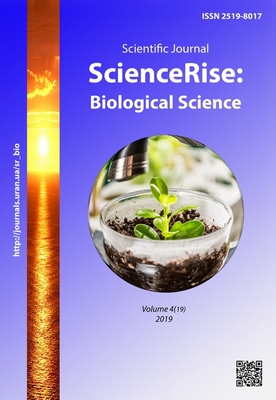Change of spatial distribution in the ichiotocenosis of the shabolat estuary in the process of its anthropogenic transformation
DOI:
https://doi.org/10.15587/2519-8025.2019.187247Keywords:
Shabolatsky estuary, formation of ichthyocenosis, gobies, mullets, flounder, population, water area, spatial distribution, anthropogenic transformation, bayAbstract
Consequences of Shabolat estuary natural ecosystems transformation under the influence of anthropogenic factors are reflected in the composition of ichthyocenosis, changes in the basic population characteristics of the most mass species.
The purpose of the work was to find out the spatial distribution of the Shabolat estuary most massive representatives of the ichthyocenosis in terms of its anthropogenic transformation.
Material and methods. The material for the study was selected from industrial fishing gear in the spring, summer and autumn periods of 2009-2012. A complete biological analysis of fish (goby round, goby grass, flounder, flounder, mullet pilengas, etc.) was carried out according to the conventional method.
Result. The regularities of formation of ichthyocenosis largest masses populations were studied depending on: water salinity, connection with adjacent water areas, fish acclimatization and introduction, anthropogenic loading and peculiarities of spatial distribution of ichthyocenosis largest masses populations in aquatics.
The most important Shabolat estuary ichthyocomplex components include representatives of the Gobiidae family, the Platichthys luscus population and the mullet family representatives.
Of particular interest to the members of the goby family are the mass species of gobies: the round goby Neogobius melanostomus and the grass goby Zosterisessor ophiocephalus, which are able to hibernate and reproduce in the estuary. This is an important link in the food chains of the reservoir. By entering into competition with other representatives of ichthyocenosis, they significantly affect the state of the forage base and production capacity of the estuary.
Representatives of the mullet family and gloss flounder are distributed in the estuary deep water areas and in areas with maximum salinity.
Conclusions. It has been established, that in the conditions of anthropogenic transformation of the estuary, in the last 35-40 years, the round goby and grass goby numbers and distribution range have decreased. In bulk, they have survived only in reservoir small, local areas, due to the deterioration of reproduction conditions and the degradation of the zoster and reddest associations. The main reasons for the decline in the size and distribution range of gobies in the Shabolatsky estuary was their mass death as a result of a large-scale environmental catastrophe and reproduction conditions deterioration. The reason for the significant decrease in the flounder and mullet number and distribution range was the mass death in 1992, as well as changes in the salinity of the Shabolat estuary
References
- Burhaz, M. I. (2018). Osoblyvosti formuvannia ikhtiotsenozu Shabolatskoho lymanu v umovakh antropohennoi transformatsii vodoimy. Odessa, 20.
- Shekk, P. V., Burgaz, M. I. (2016). Ikhtiofauna SHabolatskogo limana. Mezhdunarodnaia associaciia khranitelei reki « Eco-TIRAS» Sbornik nauchnykh statei, Akademiku L. S. Bergu –140 let. Bendery, 576–580.
- Babaian, K. E. (1961). Razvedenie kefali v lagunakh. Rybnoe khoziaistvo, 77–78.
- Pesenko, Iu. A. (1982). Principy i metody kolichestvennogo analiza v faunisticheskikh issledovaniiakh. Moscow: Nauka, 287.
- Shekk, P. V., Burgaz, M. І. (2017). Sovremennaia strategiia pastbischnoi marikultury v solonovatovodnykh limanakh severo-zapadnogo Prichernomoria. Aktualnye nauchnye issledovaniia v sovremennom mire. Pereiaslov Khmelnickii, 3 (23 (4)), 22–31.
- Burgaz, M. (2017). Distribution, biology and status of population of Neogobius Melanostomus legs and thriver (Zosterisessor Ophiocephalus) in Shabolatsky liman. ScienceRise: Biological Science, 6 (9), 31–36. doi: http://doi.org/10.15587/2519-8025.2017.119833
- Orlova, L. N. (1977). Povyshenie promyslovoi produktivnosti pribrezhnoi zony severo-zapadnoi chasti CHernogo moria i Prichernomorskikh limanov «Biotekhnika vyraschivaniia kompleksa prudovykh ryb». Otchet o vypolnenii NIR v 1977 g. No. Gosregistr. 0112.7112331. Odesskoe otdelenie IUgNIRO. Odessa, 61.
- Shekk, P. V., Kriukova, M. I. (2010). Ocenka kormovoi bazy i perspektivy ispolzovaniia SHabolatskogo limana dlia pastbischnoi marikultury. Vіsnik zaporіzkogo nacіonalnogo unіversitetu, 1, 1126–1135.
- Burhaz, M. (2019). Spatial distribution, dimensional-mass and age structure of dab of the gloss Platichthys luscus population of Shabolatsk Liman. ScienceRise: Biological Science, 2 (17), 18–23. doi: http://doi.org/10.15587/2519-8025.2019.169657
- Shekk, P., Burgaz, M. (2017). Characteristic of feeding of mullet fishes in Shabolatsky estuary. ScienceRise: Biological Science, 4 (7), 21–26. doi: http://doi.org/10.15587/2519-8025.2017.109290
Downloads
Published
How to Cite
Issue
Section
License
Copyright (c) 2019 Pavel Shekk, Maryna Burhaz

This work is licensed under a Creative Commons Attribution 4.0 International License.
Our journal abides by the Creative Commons CC BY copyright rights and permissions for open access journals.
Authors, who are published in this journal, agree to the following conditions:
1. The authors reserve the right to authorship of the work and pass the first publication right of this work to the journal under the terms of a Creative Commons CC BY, which allows others to freely distribute the published research with the obligatory reference to the authors of the original work and the first publication of the work in this journal.
2. The authors have the right to conclude separate supplement agreements that relate to non-exclusive work distribution in the form in which it has been published by the journal (for example, to upload the work to the online storage of the journal or publish it as part of a monograph), provided that the reference to the first publication of the work in this journal is included.









